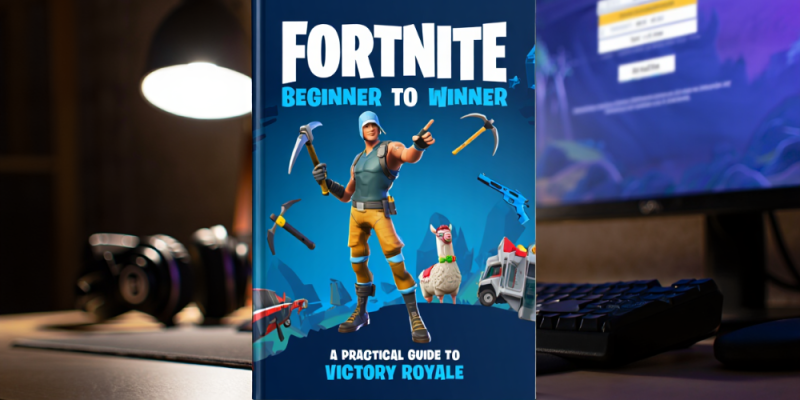Fortnite Beginner to Winner: A Practical Guide to Victory Royale
- Landon White
- October 28, 2025

Fortnite looks bright and playful, but it’s a deep battle royale with many systems. This guide gives you clear steps to improve fast in both Build and Zero Build. We’ll cover settings, landing, loot, weapons, movement, combat, and smart rotations. The goal is simple: fewer random deaths, more control, and steady progress toward Victory Royale.
Everything here uses plain language and practical tips you can try today. The meta changes each season, but core skills stay useful: good crosshair placement, smart inventory choices, clean movement, and strong decision-making. Read a section, jump into a few matches, then return and add the next skill.
Main Guide
Know Your Modes
Fortnite offers Build (classic) and Zero Build. In Build, you gather materials and place walls, ramps, floors, and cones for defense and height. Edits help you create angles and control fights. In Zero Build, cover, movement items, and positioning matter most. Decide which mode you want to focus on first; the core gunplay is shared, but how you survive is different.
Smart Settings for Instant Gains
Turn on “Visualize Sound Effects” if you struggle to track steps or shots. Use performance or lower graphics for stable FPS. On controller, pick a sensitivity that lets you track targets without over-aiming; Linear gives snappier aim, Exponential is smoother. On mouse, try a low-to-medium sens so small wrist moves adjust your crosshair. Set preferred item slots so your weapons always land in the same place. Bind a dedicated key for crouch, edit, and confirm to reduce misinputs.
Landing and Early Game
Pick a landing spot with 3–5 chests, ground loot, and at least one escape route. Land on a weapon first, then shield, then extra heals. If you drop hot (named POI), fight fast and claim the area. If you drop quiet (small landmark), focus on loot paths and leave before the storm forces you. Break furniture and ammo boxes for mats and supplies; keep your head on a swivel and avoid loud harvesting if enemies are close.
Weapons and Inventory Basics
Carry one close-range weapon (shotgun or strong SMG), one mid-range (assault or marksman), and one long-range if the season supports it (DMR or sniper). Keep at least one healing slot (meds) and one shield slot. The last slot is for utility: mobility or grenades. Upgrade rarity when it’s cheap and clear, but do not overpay early. Swap out low-accuracy guns if bloom makes you miss; tap-fire or burst at range to control spread.
Movement and Positioning
Use sprint, slide, mantle, and crouch to stay a smaller target and to break line of sight. Move from cover to cover, even in open fields—rocks, trees, walls, and ridges are your friends. Avoid low ground in open fights. Hold high ground or off-angles so enemies must expose themselves. When third parties arrive, pause, heal, and reposition rather than tunneling on a downed enemy.
Combat Fundamentals
Keep your crosshair at head or chest level as you move. Pre-aim common peeks and doorways. Start fights on your terms: shoot first from cover or from a smarter angle. In close range, open with a shotgun shot and swap to SMG to finish. In mid-range, strafe and counter-strafe, bursting to keep accuracy. Always reload before you rotate and after each fight. If your shields break, disengage behind cover, place builds (in Build), or use mobility to reset.
Building and Editing (Build Mode)
Learn a simple defensive box first: wall, wall, wall, wall, a roof (cone), and a floor. From there, practice right-hand peeks by editing a corner window on your wall. Use ramps to claim height, and place cones in enemy boxes to block their edits (piece control). Keep builds minimal and tidy; waste fewer mats, fight smarter angles. Edit drills to practice: wall edit (corner), ramp flip, and floor/roof replace. Speed comes after clean, correct inputs.
Zero Build Tactics
Since you can’t build cover, scout more, shoot less. Hold natural high ground and pre-plan rotations across strong terrain. Carry mobility every game if possible. Open fights with beam damage from mid-range, then push when you crack shields. Deployable cover and vehicles (when available) can help cross unsafe zones, but avoid driving straight lines. Grenades and utility clear campers or force enemies out of power positions.
Rotations, Storm, and Mid–Late Game
Plan two circles ahead. Rotate early to claim a safe edge or center power position rather than running late with the crowd. Use short sprints between cover, and hold angles on rotating players for easy tags. In the late game, value safety over flashy plays—reset, heal, and gatekeep edges to pick off runners. Only take a 50/50 if the reward is huge (mythic loot, zone control), otherwise choose fights you can win fast.
Duo and Squad Play
Assign simple roles: entry (starts fights), anchor (holds position), support (heals and utility), and scout (info). Call targets by description and direction. Double-swing angles together and trade knocks. Share resources after every fight: shields, ammo, mats, and mobility. Revive in safe cover, smoke or distract if the season allows, and know where the nearest Reboot Van is. Avoid splitting too far; distance kills team fights.
Economy and Risk Management
Do not spend all gold or bars early unless a key upgrade changes your odds. Keep enough for endgame rerolls or buys that matter. Only carry rare items if you can feed them ammo or charges; a fancy gun with no ammo is dead weight. Learn when to disengage: use walls, smokes, or mobility, break line of sight, and rotate. Survive first, loot later.
Common Mistakes to Drop
- Hip-firing at long range; instead, burst or aim down sights.
- Chasing a single elimination across open ground.
- Healing in view; always heal behind cover or inside a box.
- Reloading mid-fight in the open; swap weapons or build cover first.
- Landing at the same POI every time without learning a safe backup spot.
Simple Practice Routine
Spend 10 minutes on aim: tracking and small flicks in creative or an aim map. Do 5 minutes of build/edit drills (or cover movement if Zero Build). Play 3–5 real matches focusing on one goal (better landing, safer mid-game, or cleaner endgame). After each match, name one thing you did well and one thing to fix. Small, steady improvements add up fast.
PC and Console Quick Wins
- PC: Use a frame cap a bit below your average FPS to reduce stutters.
- PC: Lower shadows and effects first; keep textures moderate for clarity.
- Console: Pick Performance mode when available for smoother frames.
- All: Keep HUD readable; scale down clutter so you see enemies sooner.
Conclusion
Fortnite rewards calm plans and solid basics. Choose your mode, set smart controls, land with purpose, build or move for safety, and take fair fights. Protect your shields, rotate early, and use terrain or pieces to control angles. If you practice a little every day and review small mistakes, you will see more late games and more wins.
- Pick one focus each session: landing, aim, or rotations.
- Carry heals and mobility every game, even if it means dropping a second AR.
- Use right-hand peeks in Build; use ridges and rocks in Zero Build.
- Rotate early to power positions; third-party with discipline.
- Communicate clearly in teams: positions, targets, and resources.
- Review one clip per day and fix the main mistake you spot.















